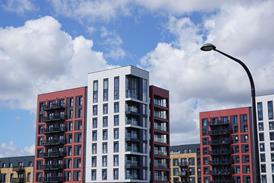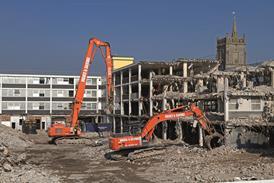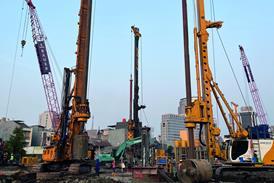It comes as no shock to find it's another jaw-dropper from architect Short and Associates and engineer Max Fordham & Partners. It marks a return to the territory they pegged out with De Montfort University's Queens Building. So, what was their plan of attack for this new campaign?
Max Fordham & Partners went for an assisted passive ventilation strategy, meaning that fans supplement the passive features in peak conditions only. This is quite a contrast to the theatre's original powered ventilation, as built by Manchester University in 1963.
Now independent from the university, the Contact Theatre Company briefed designers to extend support facilities and revamp the existing stage and auditorium.
New support facilities included a new 'studio' theatre, full-size rehearsal room, foyer, bar and restaurant, along with workshops and a bigger backstage area. Revamping the Contact Theatre meant refitting the 370-seat auditorium while retaining the original 16 m-wide stage – which was popular with the theatre group.
The Arts Council put up £4.5 million towards the £5 million building cost of the project. This lottery money was matched on paper by a grant from English Partnerships and land donated by the university. The Energy Design Advice Service also put up some money to pay for modelling work. Even so, Richard Quincey from Max Fordham & Partners acknowledged that the project was "ambitious for the budget," and some compromises were inevitable.
The existing building was a simple rectangle form with a Woodwool slab roof. New work involved tearing away part of the roof for the addition of ventilation chimneys and a 'Toblerone-shaped' roof. The project also saw extensive building to house the new facilities to the east of the 45 m x 45 m site.
Visitors enter a brightly-coloured foyer, with an attractive curved staircase drawing them up to the main auditorium. To the rear is the restaurant and a separate stair tower leading to the new studio theatre and rehearsal room, both located on the second floor.
Concealed from visitors on the ground floor is a large, double-height workshop which is as wide as the main stage. The studio theatre lies on top of this, but has been rotated 45° in relation to other spaces. It sits on a two-layered concrete slab, used to introduce air and improve acoustic performance.
The studio theatre's heavyweight room within a room arrangement is supported on walls with rubber inserts so that the studio theatre is completely isolated from other spaces. Acoustically, services engineer Richard Quincey recognises: "It will probably perform better than the main theatre, because a new building gave us more scope to design-out noise."
The studio is a theatre in the round, intended primarily for Contact Theatre's youth group – able to run independently from the main performing space. Its four extract chimneys, at 28 m, are the highest part of the structure, and protrude above surrounding buildings to announce the theatre's presence.
The whole building has very extensive disabled access – even catwalks to lighting rigs are accessible to people in wheelchairs. This was an important element of the lottery bid.
It has thermally heavy floors, walls and partitions, and both auditoriums sit atop concrete labyrinths for additional thermal storage. The original theatre had a brick inner face – originally an acoustic brick with projections that have now been removed. This brick has now been covered with a dense plaster which preserves the walls' thermal admittance.
The studio theatre has an even greater potential to absorb energy – walls, ceiling and floor are all concrete. The building fabric also contributes to fire and acoustic control, with a huge concrete sliding door isolating the main auditorium from the noisier, more fire-prone, workshop.
Economy without cutting corners
Like most theatres outside London, the Contact Theatre Company has a very tight budget for maintenance and running costs. Lottery money only covered capital costs, and there was no contribution to running costs. This provided a major stimulus to keep energy costs low by avoiding air conditioning.
"In practical terms," confessed Quincey, "maintenance is the last thing the Theatre Company will spend money on." This was a lesson from his experience on another theatre project: the Royal Exchange. Here, Quincey had examined the 30 year-old ductwork – pitifully under-maintained – and found a heating coil which "looked like the surface of the moon".
Quincey knew that plant in the Contact Theatre was very unlikely to get proper servicing attention and so, realistically, chillers simply would not have survived.
Taken together, the pressure on running costs and limited potential for aftercare steered the design team towards assisted natural ventilation. Out went the original mechanical ventilation system – unused and unpopular because it was so noisy – and in came five 23 m chimneys which would use the stack effect to draw air through the building.
Air enters the main auditorium at ground level through louvres in the west wall – the only external wall available to bring air into the space (see figure 1). It then passes through a thermal labyrinth, split into four plenums and multiple pathways, to take air into the auditorium through grilles in the floor and seating rake.
Warm air rises naturally through the auditorium, to be expelled from the building through the chimneys. These builders' works stacks have to be 2 m square in cross-section to keep down the pressure drop and maximise the updraught.
Like the intake vents, these stacks have big attenuators to prevent sound from entering the theatres. Although there is an inevitable price to pay in terms of increased pressure drop, the effect of the attenuators is very impressive (see 'Acoustic design').
The natural ventilation was designed for a maximum air flow rate of 12 m3/s – easily meeting the objective of 10 ac/h. Tests run in September found that 6 m3/s were moving through the theatre even with the dampers at 30% open.
The strategy for ventilating the studio theatre is similar, but incoming air goes through a U-bend before entering a separate labyrinth. Because the designers had a freer hand in designing the studio theatre, this labyrinth (unlike the main theatre's) is symmetrical and has equal path lengths. It is therefore self-balancing.
Across both theatres, the strategy used should mean that the small, variable speed fans fitted in the stacks rarely need to be used. The fans are single-phase, three-bladed axial units which may be programmed with a maximum speed to suit the theatre company's acoustic requirements. They will probably be used only to combat very high ambient temperatures, for night cooling, or when the wind acts against natural ventilation.
Max Fordham & Partners has not run statistical analyses using weather data to work out precisely what proportion of the time the fans will be needed. Use is likely to be light, though – not least because the theatre will only have an audience for up to 4-6 h/day, and probably less than seven days a week.
The fans had to be installed below dampers and attenuators in the main theatre – access would have been impossible otherwise. In the studio theatre, however, Max Fordham & Partners was able to locate them above the stack attenuators, with an access path from above.
Such attention to easy maintenance is a theme that runs throughout the design. High quality components were specified wherever there was a risk of failure: Woods fans, for example, and Halton dampers, to be sure of good reliability. The dampers are linkage rather than cog-operated, and they have very little play, which leads to accurate, quiet operation with low leakage.
Lighting gains can vary by a factor of five during a performance’
Loading up the heat
The main auditorium, with a maximum capacity of 370 people and heavy duty production lighting, will have substantial internal gains. Some 40 kW from people is more than matched by the design load from lighting – estimated at an average 60 kW for a full rig.
However, Max Fordham & Partners had access to measured lighting loads from other working theatres. These showed that lighting gains can vary by a factor of five through a performance, and also vary between different productions.
Most theatre lighting is mounted at high level and, naturally, most is directed at the stage. The design team used a real lighting rig and artificial heat loads simulating an audience, to run a heat load test. This test supported its layered admittance calculations and cfd modelling.
The designers found there would be pronounced stratification – with cool incoming air entirely replacing stale, warm air at seating level. Because there are no balconies in either theatre, the audience sits below the warmer stratified level – a distinct advantage for the natural ventilation system.
Wind tunnel testing by Cardiff University's Welsh School of Architecture, found that wind accelerated between neighbouring buildings affected the movement of air inside the theatre1. This showed there was a risk of negative pressure outside, near the air intake, which encouraged the designers to increase the stack height.
The H-pot arrangement at the top of the stacks came about because it was reckoned to avoid downdrafts: it generates a negative pressure whichever way the wind blows. Randall Thomas, senior partner at Max Fordham & Partners, actually made a mock-up of the H-pot using lemonade bottles. Using smoke and a simple desk fan he wanted to see for himself what goes on in this elaborate chimney pot.
Turning to deliberate, more controllable sources of heat, the theatre has two condensing boilers, sitting behind the main stage. Supplied by Broag, the 235 and 216 kW units were chosen partly because they run quietly. "Pressure jet boilers," explained Quincey, "would probably be heard through the wall."
Like the boilers, the convector heaters selected for air intakes were "very robust", claimed Quincey. They are made from mild steel rather than aluminium and have a very strong paint finish, making them difficult to damage. They also have wide gaps between fins to allow for easy cleaning.
The convector units are located in upward moving air paths – using the air's warmth to help power upward travel. In the studio theatre the heaters are installed in the U-bend at the intake.
Hybrid controls
A Trend bems controls lighting, the boilers and dampers. This was fitted by Westminster Controls –which was curious itself as to how the controls software would work in such an unusual building.
The bems software was designed in modules to make it easier to find faults and maintain the system. It uses room timeclocks, temperature and indoor air quality to gauge how much ventilation is required. Quincey said candidly that, "Air quality sensors are much cheaper than CO2 sensors."
In addition, a manual control, called an 'occupancy knob' is installed in each naturally ventilated space, allowing staff to override the ventilation setting if required. These knobs consist of a dial and a button. The dial may be turned to anything between 0 and 100 –to give an indication of how many people are using the space – and the button is pressed.
Only when the button is pressed will the computer be sent the signal. It also resets automatically.
This very simple, visual system beats over-the-top arrangements of sensors in every seat or more daunting local controls. As Quincey says, such designs are "more expensive, and more likely to go wrong".
The bems was designed bearing in mind there will be no full-time maintenance or facilities manager. Supervision is all off-site, and apart from changing the timeclocks – straightforward using the graphical panel – occupants shouldn't need to use the bems.
People working in offices or the workshop have local switches to extend heating and ventilation operating times without touching central controls.
In the unlikely event of a fire, the bems has been programmed to open the stack dampers and close the air intakes to cut the oxygen available to the fire and provide some beneficial smoke extraction.
Lighting controls are very simple, and were largely dictated by Manchester local authority's stringent licensing requirements. All public areas must have emergency lighting on during all occupied hours.
Indeed, the emergency lighting extends to all public areas and forms the skeleton of the lighting layout. This offers a concrete benefit in making it easy to access controls for additional decorative and circulation lighting.
However, Manchester's rules meant that a big chunk of the lighting budget had to go on emergency lighting – the design team was forced to spend £30 000 on the central invertor equipment alone, leaving little for other interior lighting.
The budget for external lighting was similarly squeezed – due largely to a higher than expected cost for building fabric. This forced designers to sacrifice their original plan for a fibre optic system with an iridescent colour wheel washing down the zinc-clad front facade.
However, they were able to retain a simple matrix of six Holophane wallwashers on the front facade. Downlighters and some concealed fluorescent tubes went to complete the external lighting picture.
Quincey says light pollution in central Manchester is enough to silhouette the dramatic shape of the stacks. Overall, considering the total cost was only a "couple of thousand pounds", he is extremely pleased with the lighting effect.
Bearing in mind the great pressure on capital and running costs for this project, how do likely energy costs weigh up against a more traditional building? Max Fordham & Partners compared it to a more conventional building rather than setting energy targets – partly because of the inevitable variance resulting from inconsistent use, occupancy and stage lighting.
On the ventilation side alone, Max Fordham & Partners' estimates suggest that the Contact Theatre will use 2000 kWh/y, against about 55 000 kWh/y for a design with mechanical ventilation and comfort cooling. Assuming an energy cost of 5 p/kWh, it will save about £4000/y.
Acoustic design
The Contact Theatre has three noisy neighbours, so acoustician Cambridge Architectural Research really had its work cut out. The student union’s concert venue is right next door, and a penetrating bell-tower and the busy Oxford road are within easy earshot. The unventilated concert venue opens its doors during a performance – doors that directly face one side of the new building. CAR’s Tim Lewers measured 100 dBA just outside the student union venue door. The two theatres are of different designs and therefore presented slightly different noise problems. The studio theatre is built on rubber pads, so it offers excellent sound insulation qualities, and means that the two spaces are acoustically independent. The biggest acoustic challenge was preventing noise from entering the auditoriums through the air paths into and out of the building. Lewers used “gigantic” air splitters in the main auditorium supply ducts: 2 m long x 250 mm thick. Similar attenuators were used in the studio theatre, at half the length. The splitters were made from mineral wool, and had to be these dimensions to attenuate to 12 dB at the 63 Hz octave band (which falls between the lowest note a human can sing and the lowest note of a double bass). In addition to the splitters, air entering the auditoriums is forced to turn corners, which further attenuates noise. Further mineral wool air splitters are used in the stacks – to prevent noise using this path into the space. Here too, a thickness of 250 mm and length of 2 m was required for sufficient attenuation. Ultimately, though, the main auditorium’s old roof is the weak acoustic link in the main auditorium. This would have been too expensive to replace. Despite this handicap, the acoustic design is so successful that background noise meets NR20 – far less than the norm for mechanically ventilated theatres – and wind is inaudible inside the building. Inside the main auditorium, a corrugated layer of dense plaster was required to rid the space of an unpleasant flutter echo, while acoustic material on the rear wall absorbs any reflection of sound from this surface. The reverberation time of the auditoriums, at about 1 second across the frequency range, is “ideal for a theatre,” said Lewers.Downloads
Figure 1
Other, Size 0 kb
Source
Building Sustainable Design



















